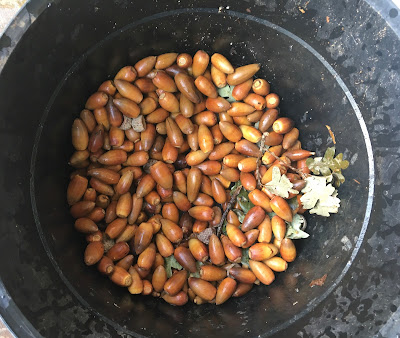
Tree planting set for Saturday at Stone Lakes wildlife refuge

|
|
It doesn’t take long for acorns to grow into oak trees. Oak seedlings
will be planted Saturday at Stone Lakes National Wildlife Refuge. (Photo: Kathy Morrison) |
Get more exercise. Help the environment. Volunteer.
Do those actions sound like your new year’s resolutions? Then, you’re in luck. On Saturday morning , the Sacramento Tree Foundation is hosting a tree planting event that covers all three.
From 8:45 a.m. to 1 p.m. Saturday, Jan. 8 , SacTree volunteers will plant up to 150 native tree seedlings at Stone Lakes National Wildlife Refuge in Sacramento County. Registration is free but limited; volunteers should sign up in advance to get directions and save their spots.
“Help us reforest the riparian oak woodlands of the Stone Lakes National Wildlife Refuge,” says the foundation. “In partnership with refuge staff and the County of Sacramento, we will be planting up to 150 native tree seedlings along the upper reaches of Snodgrass Slough. Reforestation is underway at this location to secure and improve the wildlife habitat protected and stewarded by our only local National Wildlife Refuge. This event will be a great opportunity to learn more about locally native trees, wildlife habitat, and to see some of the migratory waterfowl that visit Stone Lakes in the winter.”
This tree planting event is no walk in the park. Volunteers will need to hike 1 mile across muddy cow pastures to get to the planting sites, then 1 mile back to the parking lot.
:This project will require significant physical exertion and may not be appropriate for all participants,” warns SacTree. “ You will get wet and muddy at this event. Rubber boots and rugged outdoor-wear are highly recommended.”
Volunteers must commit to the full four-plus hours, too.
“All attendees must meet the group at check-in and be able to stay for the entire event,” says SacTree. “ Late arrivals and early departures cannot be accommodated due to access requirements. We will be working in an area of the refuge that is not open to the public and travel to and from the site must be supervised by Sacramento Tree Foundation staff.”
Bring your muscle but leave tools at home.
“We provide all the necessary tools and supplies to care for trees,” SacTree says. “Participants will receive a short, hands-on training on site. After learning the tools and techniques, participants will split up into groups and begin planting trees on residential properties.”
Once registered, participants will get directions to the Stone Lakes parking lot and more details.
Sign up here: https://sactree.org/event/native-tree-planting-at-stone-lakes-national-wildlife-refuge/
For more information: www.sactree.com .
Comments
0 comments have been posted.Sacramento Digs Gardening to your inbox.
Food in My Back Yard Series
May 6: Maintain soil moisture with mulch for garden success
April 29: What's (already) wrong with my tomato plants?
April 22: Should you stock up on fertilizer? (Yes!)
April 15: Grow culinary herbs in containers
April 8: When to plant summer vegetables
April 1: Don't be fooled by these garden myths
March 25: Fertilizer tips: How to 'feed' your vegetables for healthy growth
March 18: Time to give vegetable seedlings some more space
March 11: Ways to win the fight against weeds
March 4: Potatoes from the garden
Feb. 25: Plant a fruit tree now -- for later
Feb. 18: How to squeeze more food into less space
Feb. 11: When to plant? Consider staggering your transplants
Feb. 4: Starting in seed starting
Sites We Like
Garden Checklist for week of May 11
Make the most of the lower temperatures early in the week. We’ll be back in the 80s by Thursday.
* Plant, plant, plant! It’s prime planting season in the Sacramento area. Time to set out those tomato transplants along with peppers and eggplants. Pinch off any flowers on new transplants to make them concentrate on establishing roots instead of setting premature fruit.
* Direct-seed melons, cucumbers, summer squash, corn, radishes, pumpkins and annual herbs such as basil.
* Harvest cabbage, lettuce, peas and green onions.
* In the flower garden, direct-seed sunflowers, cosmos, salvia, zinnias, marigolds, celosia and asters. (You also can transplant seedlings for many of the same flowers.)
* Plant dahlia tubers.
* Transplant petunias, marigolds and perennial flowers such as astilbe, columbine, coneflowers, coreopsis, dahlias, rudbeckia and verbena.
* Keep an eye out for slugs, snails, earwigs and aphids that want to dine on tender new growth.
* Feed summer bloomers with a balanced fertilizer.
* For continued bloom, cut off spent flowers on roses as well as other flowering plants.
* Add mulch to the garden to maintain moisture. Mulch also cuts down on weeds. But don’t let it mound around the stems or trunks of trees or shrubs. Leave about a 6-inch-to-1-foot circle to avoid crown rot or other problems.
* Remember to weed! Pull those nasties before they set seed.
* Water early in the day and keep seedlings evenly moist.